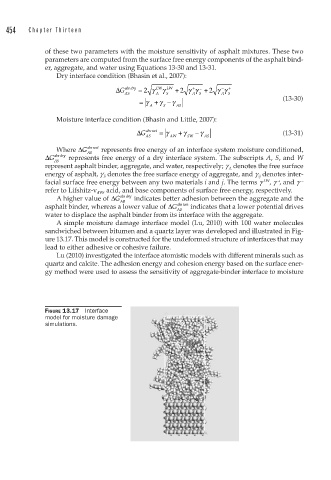Page 462 - Mechanics of Asphalt Microstructure and Micromechanics
P. 462
454 C hapter T h ir te en
of these two parameters with the moisture sensitivity of asphalt mixtures. These two
parameters are computed from the surface free energy components of the asphalt bind-
er, aggregate, and water using Equations 13-30 and 13-31.
Dry interface condition (Bhasin et al., 2007):
+
−
ΔG abs dry = 2 γ LW γ LW + 2 γγ _ + 2 γγ +
AS A S A S A S
= γ + γ − γ (13-30)
A S AS
Moisture interface condition (Bhasin and Little, 2007):
ΔG abs wet = γ + γ − γ (13-31)
AS AW SW AS
abs wet
Where ΔG AS represents free energy of an interface system moisture conditioned,
ΔG abs dry represents free energy of a dry interface system. The subscripts A, S, and W
AS
represent asphalt binder, aggregate, and water, respectively; g A denotes the free surface
energy of asphalt, g S denotes the free surface energy of aggregate, and g ij denotes inter-
facial surface free energy between any two materials i and j. The terms g LW , g , and g
–
+
refer to Lifshitz-v dW , acid, and base components of surface free energy, respectively.
A higher value of ΔG abs dry indicates better adhesion between the aggregate and the
AB
asphalt binder, whereas a lower value of ΔG abs wet indicates that a lower potential drives
AB
water to displace the asphalt binder from its interface with the aggregate.
A simple moisture damage interface model (Lu, 2010) with 100 water molecules
sandwiched between bitumen and a quartz layer was developed and illustrated in Fig-
ure 13.17. This model is constructed for the undeformed structure of interfaces that may
lead to either adhesive or cohesive failure.
Lu (2010) investigated the interface atomistic models with different minerals such as
quartz and calcite. The adhesion energy and cohesion energy based on the surface ener-
gy method were used to assess the sensitivity of aggregate-binder interface to moisture
FIGURE 13.17 Interface
model for moisture damage
simulations.

